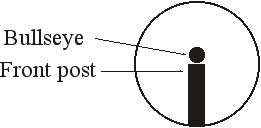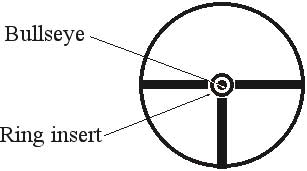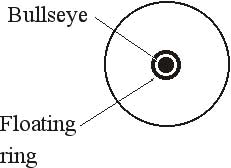Teach a person to shoot: Part 1
Teach a person to shoot: Part 2
Teach a person to shoot: Part 3
Teach a person to shoot: Part 4
by B.B. Pelletier
Sights
The best sights for training are the aperture rear and globe front with inserts. These sights are nearly as accurate as optical sights and impart quick success to student shooters. Sporting sights are much more difficult to use and can slow a shooter’s progress by months or years. An aperture sight is much more difficult to see incorrectly, and there is much less subjective judgement required to make it work.
Most inexpensive target rifles come with inexpensive sights that must be accounted for when teaching. The Daisy 5899 Receiver Sight is a good example. It’s made of plastic, so when adjustments are made they don’t always go where you think they should. Veteran shooting coaches advised my team to watch which direction we were turning the adjustment knobs; and, if we ever had to reverse directions, it was best to go three clicks in the new direction before counting the clicks. That took the slop out of the mechanism. Other inexpensive aperture sights are similar in quality, and the same rule should be used.
Front sights – post
The traditional front sight insert for beginners is the conventional post. It is the most difficult of all inserts to master and really shouldn’t be used with new shooters unless there is no other option. It requires the greatest amount of subjective judgement to use correctly. Very few modern competitors feel comfortable with this type of sight.

Globe and post front sight requires centering the top of the post in the rear aperture and positioning the bull exactly on top of the post. This takes skill and practice.
Front sights – ring
A better front insert is the ring sight. All the shooter has to do is center the bull in the ring. For many years, this was the top sight insert, until the floating ring came along.

The ring sight is much easier to use. All the shooter does is center the bull in the ring.
Front sights – floating ring
The floating ring is now favored by most competitive shooters. The ring “floats” in the front globe without visible support. All it is is a round piece of transparent plastic with a ring drilled in the center. Recently, this sight was made even better by making the ring adjustable in size and thickness. The principal advantage to the floating ring sight is that it lessens the chance of shooting at the wrong bull, because it’s possible to see all the bulls while sighting on just one.

The floating ring has no support to get in the way of seeing the entire target
Should you let a student close the non-sighting eye?
This has long been the cardinal sin in target shooting. I was taught to NEVER close my non-sighting eye, because the extra effort to close it would cause strain in a match. I have also heard that by keeping the non-sighting eye open, the shooter allows more light to enter the eyes and therefore sees the sights clearer. I don’t know what the truth actually is, and I have seen some pretty good shooters who closed one eye, but it is considered correct to keep both eyes open. Shooting glasses have blinder attachments to lower the distraction.
I didn’t get to triggers as promised in part 4, so I’ll cover them in a later post. I will also do a separate posting about open sights and how to use them. It won’t be part of this series, but you’ll see how difficult it use to use open sights correctly.
Is there a source for sights? My Rm577 was missing the rear when I bought it and so far no online shop I’ve tried has the correct part in stock as the rifle has been discontinued. I have the front sight but am trying to find a rear sight that will work with it. In this case the rear sight mounts on the scope rails I believe. Any help would be appreciated.
Bob,
Have you called Pyramyd Air?
888-262-4867
B.B.
B.B.,
When using an aperture site should the entire front globe be centered in the rear site in addition to centering the ring in the front sight. That is, should there be three concentric circles: the circle made by the rear aperture, the front globe and the front ring?
Thank you
Don’t concentrate on the globe. As long as the inner circle is centered, that’s all that matters.
By the way, your eye and brain automatically center the inner circle because thet is where the greatereswt amount of light is. That’s why a small aperture in the rear is more precise.
B.B.
Using open sights really is a pain in the neck. I’ve been using a scope ever since the first gun I got. I never even thought about it but the first time I went and tried to shoot my friends gun I couldn’t use the sights very well. Now I’m trying to teach myself using an old multi-pump airgun. Quite a challenge, caint wait to see your article on that one.
lama
BB,
I didn’t call, but I emailed and got back a response that since they no longer carried the rifle, they no longer had the parts.
Seems to me that probably most of the Mendoza’s would have the same sights. Furthermore, it seems to me that the original sights must have clamped onto the scope dovetails as there are no signs of any other screw holes or mounting hardware.
I just mounted the Bugbuster 6x (one step closer to getting the RWS 52!) on the Mendoza so it’s not a big issue. When I get the RWS I plan on transfering the Bugbuster to it so it would be nice to have the sights….something of the purist in me wanting to shoot with open sights once in a while.
Let me know if you can help and thanks for the help so far!
B.B.,
I’ve got a Beeman R7 .20 cal. that I enjoy shooting with an aperture rear sight I’ve added, and would like to find a ring, or floating ring insert for the front.
Clearly the R7 is a favourite of yours, so perhaps you can tell me if its possible to replace the standard post with a ring, or floating ring insert, and if so, where I might acquire the parts.
Bob,
It seems that Mendoza is now an orphan in the U.S. You might try Umarex USA. They took over from RUAG, who took over from RWS a couple of years ago, and RWS was the one that imported the Mendozas.
479-646-4200
B.B.
R7,
What you need is an entire replacement front globe. Try Ghampion’s Choice. Expect to pay $80-100. You’ll have to do this to get the floating ring. Try FWB, and be prepared to tell Champion’s the width of your front dovetails in inches.
A cheaper alternative would be to try an HW front sight with replaceable inserts and then find a ring insert for it.
B.B.